The Importance of Japanese Pickles (Tsukemono)
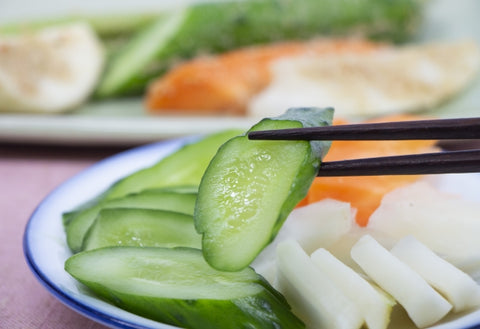
Tsukemono (lit. “pickled things”) are a staple in Japanese cuisine. Made from an infinite array of local, seasonal ingredients, tsukemono are almost always found as a side dish or garnish to any Japanese meal. They serve the purpose of cleansing one’s palate while also aiding in digestion.
History
Before refrigeration, sea salt was used to preserve meat, fish, and vegetables in Japan, while brines, fermentation, and molds eventually allowed tsukemono to become a household commodity. As trade increased and more vegetables became prevalent in Japan, the demand for pickled foods rose. By the early 1900s, tsukemono were commercialized into a major industry and became a staple wartime ration given their long shelf life.
Methods for Pickling Tsukemono

Shiozuke
Shiozuke involves using salt brines for preservation. Typically six tablespoons of salt is combined with every 4 cups of water to ensure thorough pickling.
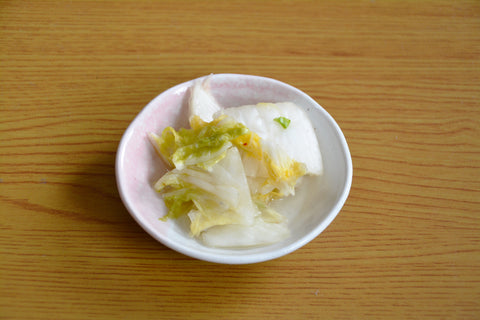
Asazuke
Asazuke, which also involves salt pickling, uses less salt and a shorter pickling time, resulting in a milder taste and crunchier texture.
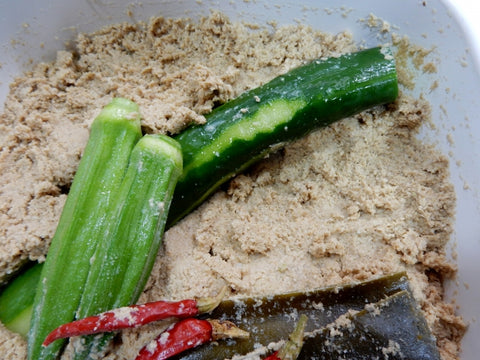
Nukazuke
Nukazuke are fermented in a rice bran called a nukadoko, which resembles wet sand and often has kombu (kelp), ginger, or salt mixed in with it. Vegetables are fermented for up to several months to develop a deep sour taste.
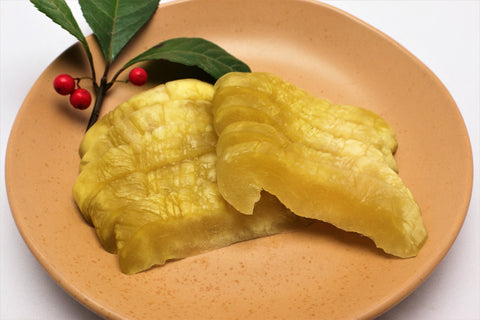
Kasuzuke
Kasuzuke are made from sake kasu (sake lees) which is the paste leftover from making sake. It is slightly alcoholic which allows vegetables to pickle for up to multiple years. It can host a variety of flavors from sweet to sour.

Shoyuzuke
Shoyuzuke involves pickling vegetables in shoyu (soy sauce). It usually takes up to one week to develop a strong flavor.
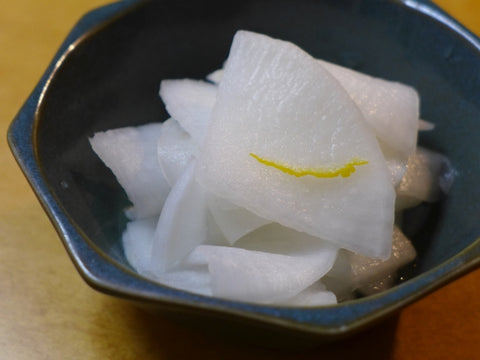
Suzuke
Suzuke are pickled with the use of vinegar and the final product is usually sweet and crisp.

Misozuke
Misozuke allows vegetables to be fermented miso for up to several months. The resulting pickle will be extremely pungent and has a strong miso taste.
Common Tsukemono
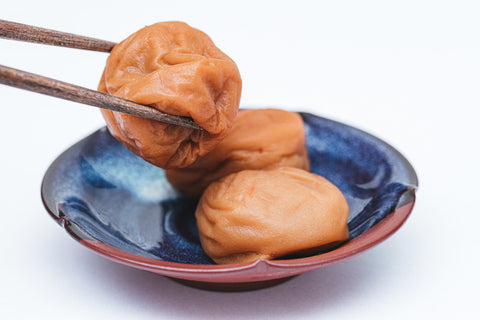
Umeboshi (pickled plums)
Japanese plums, know as ume (梅), are best described as a cross between an apricot and a plum. To make umeboshi, ume are pickled in salt creating a wrinkled plum with a soft outer flesh that is either beige or dark pink if pickled with purple shiso leaves. Their interior is extremely sour which is why they are often paired with less flavorful foods like rice or in rice balls (onigiri). The center has a pit that cannot be eaten.

Takuan
Takuan are pickled Japanese radish known as daikon. These sweet crunchy Japanese radish slices are commonly found in bento boxes or as side dishes and are often bright yellow in color when pickled with dried gardenia fruit or dyed. They are pickled using salt and sugar to provide a sweet and sour flavor.
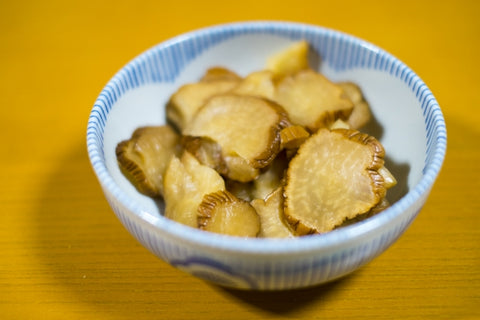
Iburigakko
Similar to takuan, iburigakko is made from daikon but is both pickled then smoked to produce a smokey tasting brown colored pickle. Iburigakko used to be a common winter tradition in Akita Prefecture when large central hearths, which were used to warm homes during the harsh snowy winters, also served as a place to cook. Fresh daikon was hung over the fire to slowly dry, allowing the smoke from the hearth to infuse a smokey flavor in the takuan. They are typically sliced thin and served over white rice or topped with cream cheese.

Gari
These thin slices of sweet yet spicy pickled ginger that are typically served alongside sushi and are either light yellow or bright pink in color. They're used to cleanse one's palete between each sushi piece.
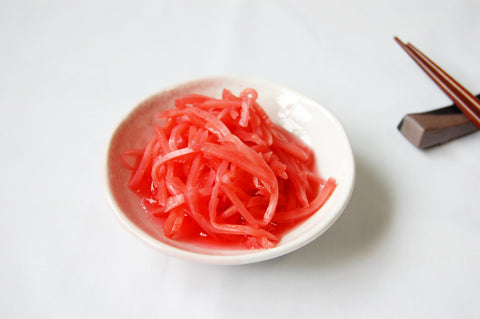
Beni Shōga
Also using ginger as a base, beni shōga are thin strips of ginger marinated in umezu, the pickling solution used to make umeboshi. Sour and spicy in taste, this tsukemono is usually paired with gyudon, okonomiyaki, and Japanese curry.
Nukazuke
Referring to both the pickle and the pickling method, nukazuke are usually made from cucumber, shallot, carrot, radish, eggplant, or a mixture of these and served as a side dish.

Kyuri Asazuke
These pickled, thinly sliced cucumbers are typically enjoyed during the summer months as a refreshing snack. It's common for households to make their own as it only requires a jar and salt brine. Try this easy recipe.

Hakusai no Sokusekizuke
A wet pickled vegetable salad containing mostly cabbage and carrots, it's said to be similar to coleslaw.
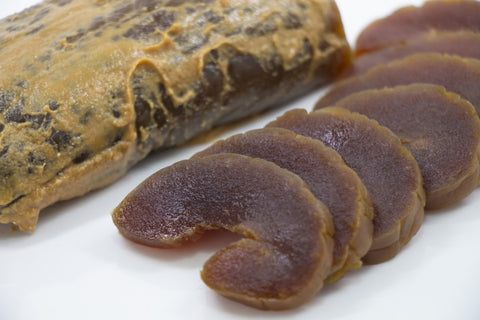
Narazuke
Brown colored pickles hailing from Nara prefecture that are normally soaked in sake lees for multiple years. The resulting pickle has a pungent odor and alcoholic taste. It is said to improve gut health by removing excess acid in the intestine acid.
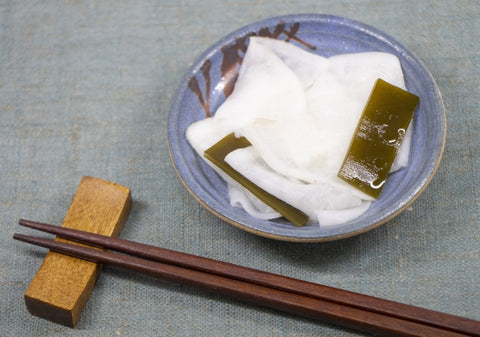
Senmaizuke
Meaning thousand layer pickle, this thinly sliced turnip marinated in sweet vinegar, konbu, and chili is a specialty from the Kyoto region.
Try making your own tuskemono at home following our Kyuri Asazuke (Japanese Pickled Cucumbers) recipe or our Yuzu Pickled Daikon (Japanese Radish) recipe.




2 comments
Thank you for your questions Caroline! You can easily make your own tsukemono at home without any special equipment. We’ve added two recipes to this blog for you to try. Let us know if you need further help!
I want to make my own tsukemono but wonder if I need special equipment to make it. I have seen pickle making pots with a lid that screws down on the pickles. Is the appropriate equipment to purchase? Do you have a brand or type preference? Any advice would be greatly appreciated.